Today, 94% of all searches happen on Google’s property: YouTube, Maps, Images, Google’s blog, etc. This means that most user search queries result in an answer provided by the search engine which comes above organic results. This usually contains the exact answer to the user’s question, so there is no need to click-through to the company’s sites.
It is clear that the search engine exerts every effort not to redirect users to third-party sites. SERPs are “captured” by zero-results.
When Google recognizes local intentions it returns a map block (the Local Pack) as a zero-result.
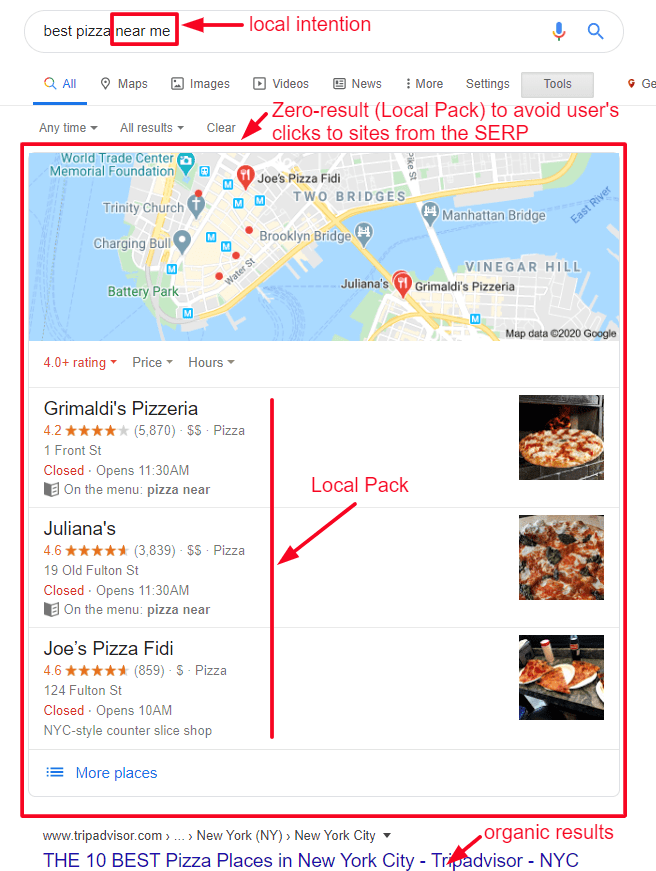
Accordingly, users receive the necessary information (addresses, contact/map details) from this block and don’t need to click-through to websites.
So, marketers and entrepreneurs are concerned about the trend of site’s traffic decreasing.
In this article, we’ll discuss if zero-click results are really a serious threat to companies and if it is possible to get the most out of this, turning it to your advantage.
How Can Zero-Results Threaten Local Companies?
About 10 years ago, if you needed, for example, a laptop repair in a certain area, you probably examined shopping centers and hardware stores in the radius to find out if they provided the services you required.
Nowadays almost everyone has a smartphone or tablet, and therefore, if you suddenly need to find a “laptop repair nearby”, “the nearest cafe” or “opticians in Manhattan”, you can simply use a mobile search. The search engine will customize the SERP in accordance with the specified parameters and return the nearest results.
So, if a user searches for goods or services locally (either it’s a commercial query like “to buy …” or a category query like “construction materials”), the search engine will always show the Map Pack with the most relevant options above the organic results.
More than half of Google searches now don’t result in a click. Google is trying to provide the necessary information on the search page to prevent users from going to companies’ websites for the purpose of monetization.
Zero-results are becoming a serious problem for businesses that expect to direct customers to their stores and offices by means of their high-ranked websites.
In June of 2019, it was found for the first time that a major part of all browser-based searches on Google (mobile and desktop) resulted in no clicks. This means that users didn’t click-through to the sites because they received the necessary information as a zero-result.
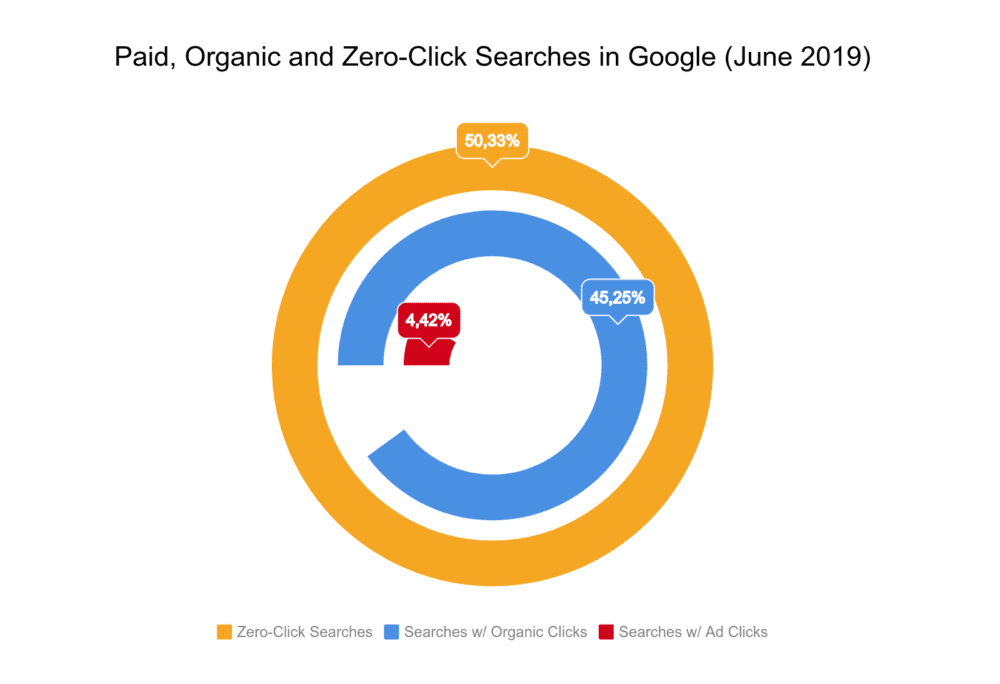
In this regard, marketers and the
Moreover, a clear pattern is observed: while searches with organic clicks shrink there is an increase in zero-click searches and searches with Ad clicks.
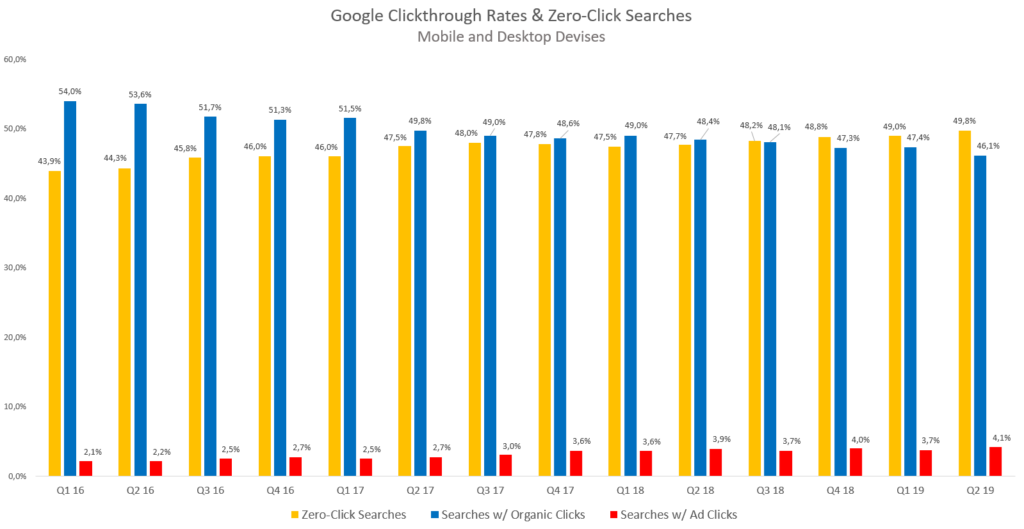
The chart below (mobile search) clearly shows the following: ads on Google began to appear more often – paid clicks have nearly tripled. Zero-click searches also grew significantly, and now they almost represent two thirds of all searches.
At the same time, organic CTR fell by almost 20%, ~62% of mobile searches didn’t result in a single click and only one out of 60 views of GMB listings ended with a click-through to a website.
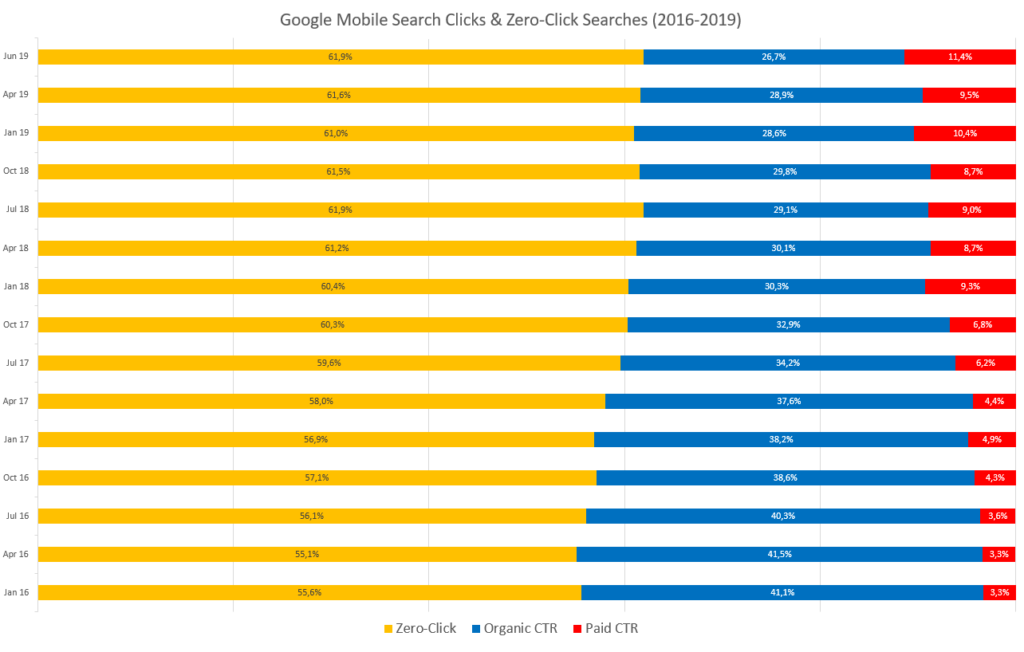
It seems quite logical not to visit third-party sites if you have found all the necessary information on the search page (for example, the actual company’s details in the Local Pack). In this case, a user is likely to call the organization or to pave the route on the map.
Moreover, take into account the fact that today’s users increasingly prefer another source of information in order to find company details – Google My Business listings.
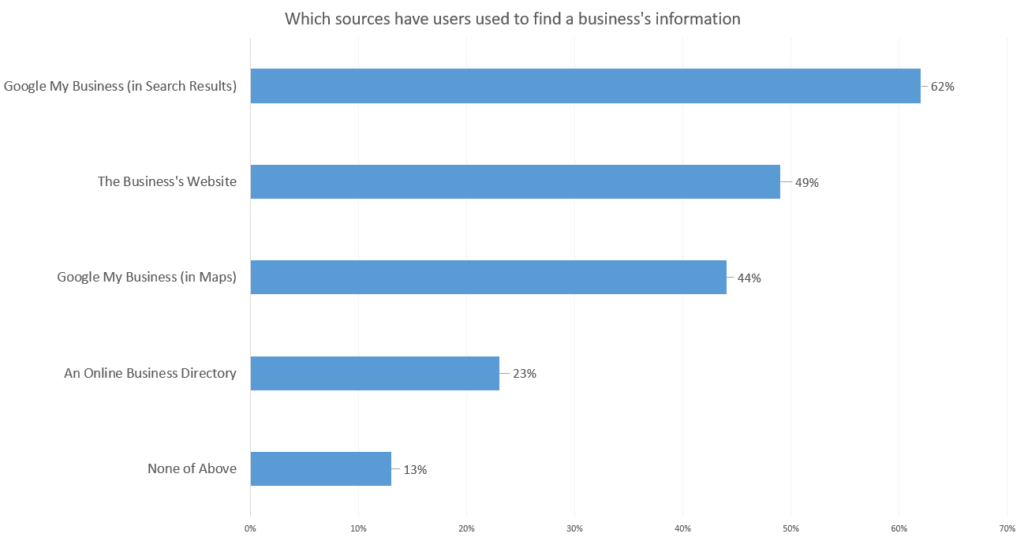
The research confirmed that 64% of consumers (combining chart data) have used Google My Business to find contact details. This means a great number of companies receive and are contacted by “warm” leads, without ever visiting a website.
So, the described changes relieve users from visiting sites and give maximum significance to Google My Business signals (by local searches).
How Can Companies Benefit From Capitalizing on Zero-Click Searches?
Although organic CTR is falling, it’s important to remember that the number of search queries remains the same.
By the way, 84% of searches for businesses are discovery. This means that a customer searches for a category, product, or service that a company offers, and its listing then appears.
So, to make your local pages become the shortcut to your store or office, first of all, claim your business listings by submitting information to Google My Business and other online directories.
The more information provided in a listing the better it affects a listing ranking. In fact, according to large-scale industry research, Google My Business signals is the most important local search ranking factor.
Tips to Boost Your GMB Listings
Check the Accuracy of Your Company’s Information on the Maps and Other Relevant Sources
Examine if there are inconsistencies or missing information and make improvements if required.
In other words, submit detailed business information about the locations to the sites and social networks working with the local search. Local links (citation signals) are perceived by the search engine positively.
Improve Your Listings
- fill in the NAPWCHD information about each branch of the company (name, addresses, phone numbers, website, categories, business hours, description). In brief, provide as much info as possible: the entire listings should be detailed and accurate with no mistakes;
- select the main and additional business categories to cover more relevant searches;
- add images to improve engagement. Images on Google My Business listings impact a user’s actions;
- work with content: create Google Posts. They can help you rank higher on generic local searches and become the response to a query: this happens by means of behavioral “signals”, improving the click-through rate.
Work With Reviews
They form a company’s star rating, which influences a company’s ranking (i.e. its position on the search engine result page). This means that reviews can help the company to get into the top three (the Local Pack), to affect the competitiveness and give an absolute advantage in attracting leads.
Moreover, by responding to reviews, you can develop dialogue with a client – this encourages customers to leave more reviews and rate your business that leads to an increase in the conversion rate.
Use Schema Markup for Local SEO
a featured snippet can help you become a zero-result.
Update the Listings in a Timely Manner
Monitor if the information is real, rejecting attempts to change it, and use the tips above to become a zero-result (the Map Pack).
When it comes to local businesses with numerous branch offices or stores it is rather difficult to monitor and optimize listings manually. So, professional solutions are designed to help.
Conclusion
Today, running ads or optimizing your site is not enough to guarantee that users will find your local stores or offices by relevant queries. Focus on local
SEO presentation -DepositPhotos


